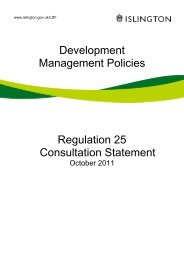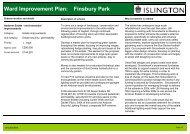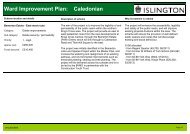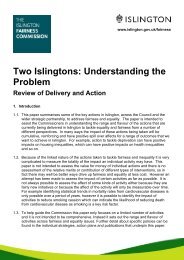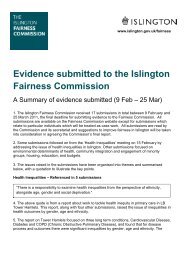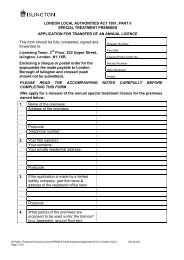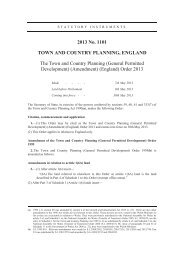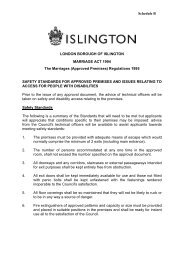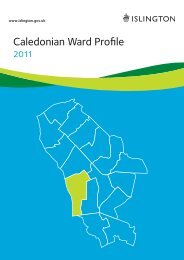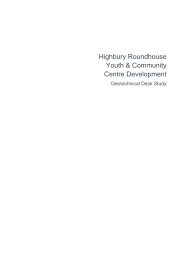Development Management Policies - Direction of ... - Islington Council
Development Management Policies - Direction of ... - Islington Council
Development Management Policies - Direction of ... - Islington Council
Create successful ePaper yourself
Turn your PDF publications into a flip-book with our unique Google optimized e-Paper software.
3 Managing Environmental Resources<br />
iii) Mixed-mode cooling, with local mechanical ventilation / cooling provided where required<br />
to supplement the above measures using (in order <strong>of</strong> preference) low energy mechanical<br />
cooling followed by air conditioning<br />
iv) Full-building mechanical ventilation / cooling systems using (in order <strong>of</strong> preference) low<br />
energy mechanical cooling followed by air conditioning<br />
B. Measures at the highest possible level <strong>of</strong> the above cooling hierarchy shall be utilised to<br />
the fullest extent possible before the next level <strong>of</strong> the hierarchy is utilised. Each successive<br />
level shall be utilised as fully as possible before the subsequent level is utilised. The use <strong>of</strong><br />
technologies from lower levels <strong>of</strong> the hierarchy shall not be supported unless evidence is<br />
provided that clearly demonstrates that technologies from higher levels <strong>of</strong> the hierarchy cannot<br />
deliver sufficient heat control.<br />
C. Applications for major developments and all developments above 100m 2 in the CAZ are<br />
required to include details <strong>of</strong> temperature modelling under projected increased future<br />
temperatures, and to demonstrate that the proposed design has maximised passive design<br />
and passive cooling measures.<br />
3.0.33 The UK Climate Impacts Programme 2009 projections suggest that by the 2080’s the UK<br />
is likely to experience summer temperatures that are up to 4.2°C higher than they are<br />
today. In dense urban areas such as <strong>Islington</strong>, the Urban Heat Island Effect<br />
3.0.34 The Urban Heat Island Effect(UHIE) could intensify these increases leading to temperatures<br />
that are as much as 9°C higher than the outskirts <strong>of</strong> London. Ensuring buildings are<br />
designed and constructed to be comfortable in higher temperatures, without resorting to<br />
energy intensive air conditioning, is crucial. This will be particularly important in the densest<br />
parts <strong>of</strong> <strong>Islington</strong> within the Central Activity Zone (CAZ).<br />
3.0.35 The hierarchy within the policy requires developments to incorporate measures which will<br />
ensure adaptation to rising summer temperatures, while minimising energy intensive<br />
cooling. Modelling <strong>of</strong> larger developments and those in the CAZ under predicted future<br />
temperatures is required to ensure buildings are fully adapted to the changing climate.<br />
Detailed requirements for modelling will be set out in the Sustainable Design SPD.<br />
3.0.36 Passive design may include building orientation, shading, high levels <strong>of</strong> thermal mass,<br />
and energy efficient lighting and appliances. Passive / natural cooling may include<br />
maximising cross-ventilation, use <strong>of</strong> passive stack ventilation, and night-time purging.<br />
3.0.37 Information submitted in relation to this policy may be submitted within the Design and<br />
Access Statement, or may be submitted within a separate Sustainable Design and<br />
Construction document.<br />
34<br />
<strong>Islington</strong> <strong>Council</strong> <strong>Development</strong> <strong>Management</strong> <strong>Policies</strong> - <strong>Direction</strong> <strong>of</strong> Travel



